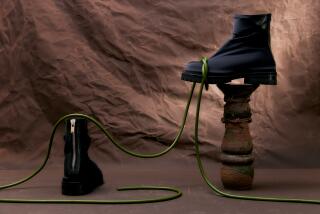BEYOND THE BOOK
- Share via
WHERE would we be without Neiman Marcus? Without the opportunity to buy a $35-million Boeing jet, a personal dirigible, a pair of camels or his and hers action figures in the buyers’ likenesses -- and all at your neighborhood department store?
And where would we be without 39 of these stores nationwide, each bearing the unmistakable NM logo that has come to symbolize everything that’s garish and elegant, extravagant and outlandish?
One hundred years ago this fall, the Dallas-based retailer opened its first store -- and celebrates the occasion with a gala benefit Friday -- and ever since, luxury peddlers have been trying to catch up to its unique concept of shoppertainment. Explaining the Neiman Marcus experience is elusive, like trying to describe the mysterious cachet that comes in that little bag.
“There is a customer for everything. You just have to seek her out,” says Karen Katz with the confidence of P.T. Barnum. Katz is president and chief executive of the Neiman Marcus Group. “We recognize that the things we have to offer our customer -- she really doesn’t need any of it. So we have to make it compelling and emotional for her to visit frequently.”
Neiman’s has excelled at making customers feel this way when they fork over $945 for Manolo Blahnik booties or $10,500 for a lacquered fur Giorgio Armani coat. I learned that during years living in Dallas and writing about fashion for the local paper. I could hardly afford anything in the store but would often visit, meeting designers and slowly browsing the racks.
Understanding desire, however, goes only so far. Neiman Marcus really began with audacity, opening a shop in the heart of a dusty frontier, Dallas 1907. It took nerve to sell cutting-edge fashion outside the world’s fashion capitals, but Herbert Marcus Sr., his sister Carrie Marcus Neiman and her husband, A.L. Neiman, weren’t about to let location get in their way. They knew myth-making and fantasy play a critical role in merchandising style and fashion.
The store made its retail mark -- without ever planting a flag in New York City -- by introducing the first electronic gift card, turning limited-edition shopping bags into status symbols and becoming the first luxury retailer to embrace e-commerce. The parties, the two-week sales events and the 5,000 pieces of fine art sprinkled throughout its stores helped too.
Unwilling to let fashion editors call all the shots, it published a Christmas catalog filled with over-the-top wish lists and, in 1996, launched its own magazine, known simply as the Book. With glossy pages and designer profiles, the Book soon became one of the most loved and hated, parodied and drooled-over vehicles for self-promotion within the industry.
Michael Faircloth, the Dallas designer who dressed Laura Bush for her first inaugural ball, credits working at Neiman Marcus during college as an early fashion influence. “It put me in contact with beautifully made clothes from all over the world and the clients who buy these clothes,” said Faircloth. “I also learned the nuances of selling to these people and listening to what they have to say.”
Cultivating its sphere of influence, Neiman Marcus invited the fashion industry to its front door, and the key players -- Christian Dior, Gabrielle Chanel, Bill Blass -- responded, showing up and helping to build an atmosphere conducive to sales and appreciation. Just last month, Giorgio Armani spent three days in Dallas, staging a sold-out charity fashion show before 1,000 fans and staying for an hours-long book signing. Among the guests? Lance Armstrong.
But beyond nameplates and celebrity, the store is an open seduction, and its approach is to flatter, no matter the customer’s means. As a young couple shopping for an engagement ring in the Dallas store, my fiancé and I were shown the biggest diamond available -- a 10-carat, pear-shaped rarity, wildly out of our price range. But the offer still lingers in my mind.
On another visit, I recall watching an enormous beehive hairdo emerge from the escalator, with a woman of a certain age beneath it. And a closer look at her elegantly embroidered jacket brought a shock. It was the work of Alexander McQueen, a then-obscure hero of the avant-garde who would soon become the rage with his exacting tailoring and sharp suits.
At that moment, I realized Neiman’s greatest secret: Never underestimate the customers’ need to create their own vision of style, whatever it may be. And if they have a bank account to match, so much the better.
--






